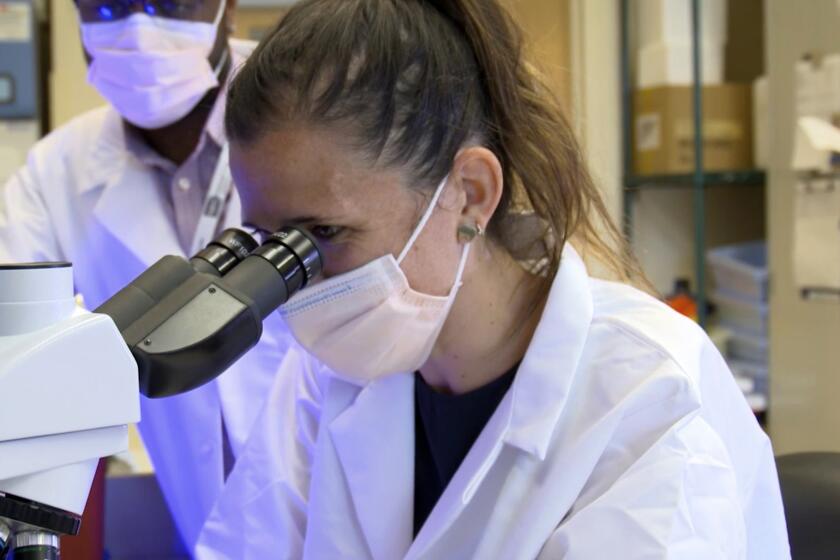General Electric chemist invented process for making diamonds in lab
- Share via
H. Tracy Hall, the physical chemist who invented the first reproducible process for making diamonds in the laboratory, kicking off a multibillion-dollar industry, died Friday at his home in Provo, Utah. He was 88 and had Alzheimer’s disease and diabetes.
The feat, considered on a par with converting lead into gold, had been a goal of chemists, alchemists, physicists and scam artists for more than two centuries when Hall -- ostensibly part of a team at General Electric but working primarily on his own -- pulled it off.
Those first diamonds were small to the point of near invisibility and nowhere near the quality that might be required for jewelry. But they were perfect for a variety of industrial applications that involved cutting, grinding and polishing a range of once-intractable materials.
The material is also finding growing use in the electronics industry and, as new techniques have allowed the production of stones as large as 12 carats, in the jewelry business as well.
Hall should have received a Nobel Prize for his work, said earth scientist Robert M. Hazen of George Mason University, author of a book about the creation of the man-made diamond industry.
The search for artificial diamonds was triggered by the 1797 discovery that a diamond is a form of pure carbon, converted into crystalline form by high temperatures and pressures.
Over the centuries, researchers tried various clever ways of producing the desired conditions, occasionally claiming the production of one or more stones. But their work was never reproducible, and most observers argued that the stones had been secretly added to the experiments by sympathetic colleagues or by the researchers themselves.
When Hall joined GE’s Project Superpressure at Schenectady, N.Y., in 1953, the company was in the process of purchasing a massive, $125,000 press that could generate a pressure of 1.6 million pounds per square inch in a small, confined space.
Hall had built a pressure chamber that he called the “half-belt” that had been used to create high pressures in a 35-year-old Watson-Stillman press that leaked so much water from its hydraulics that he had to wear rubber boots while working with it.
When he envisioned a better pressure chamber, the company refused to come up with the $1,000 it would require and refused him official time in the GE machine shop to build it. He persuaded a friend in the shop to do the work during off hours, and a former supervisor persuaded the company to purchase the expensive carboloy (tungsten carbide dispersed in cobalt) that he needed to produce it.
After several false starts, Hall ran a final test in the new device on Dec. 16, 1954, when other researchers in the lab had already left for Christmas vacation.
When he unsealed the apparatus after the experiment, he later said, “My hands began to tremble; my heart beat rapidly; my knees weakened and no longer gave support. My eyes had caught the flashing light from dozens of tiny . . . crystals.”
Hall repeated the experiment several times, achieving the same results. On New Year’s Eve, GE chemist Hugh H. Woodbury used Hall’s equipment to perform the experiment, becoming the second person to make artificial diamonds. A week later, Hall reported his results to GE officials, who suspected that he was exaggerating his findings.
But when the experiment was repeated in front of them -- with Hall safely out of the building -- the results were the same. On Feb. 14, 1955, the company breathlessly announced that it had created the first synthetic diamonds, and the results were trumpeted in newspapers across the country.
The news release, however, implied that the diamonds had been made in the company’s expensive new press.
Hall’s reward? A $10 savings bond. “Big deal,” he said later.
Disheartened by the lack of credit, he began looking for another job, landing at Brigham Young University in Provo, where he planned to do high-pressure research. But the federal government had slapped a secret label on the apparatus, which effectively prevented Hall from using it.
His solution was to invent another apparatus, called the tetrahedral press, that was even better and that circumvented all the patents held by GE. He published his research in a widely read journal, but shortly thereafter, the government slapped a secret label on that device as well. A few months later, however, the military lifted the veil of secrecy, and he was finally able to use the fruits of his labor.
Hall and two colleagues later started a new company called MegaDiamond in Provo, and the area still remains a nexus of synthetic diamond production.
Howard Tracy Hall was born Oct. 20, 1919, in Ogden, Utah. His childhood hero was Thomas Edison and, by the fourth grade, Hall’s goal in life was to work for General Electric, which was closely associated with the inventor.
He enrolled at the University of Utah, receiving his master’s degree in 1943 before spending the rest of the war years as a Navy ensign. After the war, he returned to Utah for his doctorate and ultimately persuaded GE to hire him.
He was active in the Church of Jesus Christ of Latter-day Saints, and he and his wife, the former Ida Rose Langford, served a mission in Zimbabwe and South Africa in 1982-83. After his formal retirement from BYU, he became a tree farmer in Payson, Utah.
Ida Rose Hall died in 2005. Hall is survived by six daughters, a son, four brothers, 35 grandchildren and 53 great-grandchildren.
--






